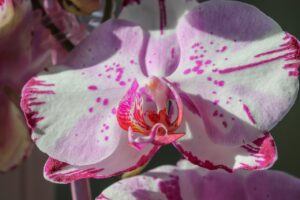If you’re an orchid enthusiast, you know that finding the perfect pot for your orchids can make all the difference in their growth and overall health. In this article, we explore the world of orchid pots and discuss the various options available to help you choose the best pot for your beautiful blooms. From clay pots to plastic containers, we’ll delve into the pros and cons of each type, providing you with the necessary knowledge to make an informed decision for your beloved orchids. So, let’s uncover the secrets to finding the ideal pot that will nurture your orchids and enhance their flourishing beauty.

This image is property of pixabay.com.
Factors to Consider for Choosing an Orchid Pot
When it comes to choosing an orchid pot, there are several important factors that you should consider to ensure the health and well-being of your orchids. These factors include drainage, material, size, shape, and aesthetics.
Drainage
One of the most crucial factors to consider when choosing an orchid pot is drainage. Orchids require excellent drainage to prevent root rot and promote healthy growth. The pot you choose should have sufficient drainage holes at the bottom to allow excess water to escape easily. Without proper drainage, the roots of your orchid can become waterlogged, leading to the death of the plant.
Material
The material of the orchid pot can have a significant impact on the overall health and growth of your orchids. There are various pot materials to choose from, including clay, plastic, ceramic, wooden, and glass. Each material has its own advantages and disadvantages, which we will explore further in the following sections.
Size
Choosing the right size of pot for your orchids is essential for their well-being. Orchids generally prefer to be slightly root-bound, meaning their roots like to be snug in the pot. However, if the pot is too small, it can lead to the roots becoming overcrowded and restricted. On the other hand, if the pot is too large, it can retain too much moisture and increase the risk of root rot. It’s important to find the right balance and choose a pot that allows for some growth but isn’t excessively large.
Shape
The shape of the orchid pot is another consideration to keep in mind. Most orchids have aerial roots that require space to grow and absorb moisture from the surrounding air. Look for pots with a shape that accommodates the unique growth habits and requirements of your orchid species.
Aesthetics
While not necessarily a crucial factor for the health of your orchids, the aesthetics of the pot can still play a role in your overall enjoyment of growing orchids. Choose a pot that complements your personal style and the decor of your home or garden. There are plenty of beautiful and stylish pots available that can enhance the visual appeal of your orchid displays.
Different Types of Orchid Pots
Now that we have discussed the important factors to consider when choosing an orchid pot, let’s explore the different types of pots available in the market. Each type has its own unique characteristics and benefits.
Clay Pots
Clay pots are a popular choice among orchid enthusiasts for several reasons. They are known for their excellent drainage properties, which is vital for maintaining the health of orchid roots. Clay pots allow excess water to evaporate through the porous walls, preventing the roots from becoming waterlogged. They also provide stability for top-heavy orchids and help to regulate moisture levels due to their porous nature. However, clay pots can be prone to cracking and breaking, especially in colder climates, and they may require frequent watering due to the evaporation. Additionally, they can be heavier than other pot materials.
Plastic Pots
Plastic pots are lightweight, durable, and affordable, making them a popular choice for many orchid growers. They are generally available in a wide range of sizes and shapes, providing ample options for different orchid species. Plastic pots also retain moisture well, which can be beneficial for certain orchid varieties or in drier environments. However, they may not provide as good drainage as clay pots, and their non-porous nature can lead to stagnant moisture if not managed properly. Over time, plastic pots can also become brittle and crack under extreme temperature changes and excessive UV exposure.
Ceramic Pots
Ceramic pots are known for their aesthetic appeal and are often chosen for their decorative qualities. They come in a vast array of colors and designs, making them a delightful addition to any orchid collection. Ceramic pots are generally heavier than plastic or clay pots, providing stability for top-heavy orchids. They also retain moisture well, which can be advantageous in certain environments. However, like clay pots, ceramic pots can be prone to cracking if subjected to extreme temperature fluctuations. They may also be more expensive compared to other pot materials.
Wooden Pots
Wooden pots offer a unique and natural aesthetic to orchid displays. They are favored for their ability to provide a more natural growing environment for orchids. Wooden pots excel at aerating the roots and allowing excellent air circulation, which is beneficial for orchids with aerial roots. They also have good drainage properties and can retain moisture without becoming waterlogged. However, wooden pots require careful maintenance and should be monitored closely for signs of rot or decay. They may also need to be replaced periodically.
Glass Pots
Glass pots are a visually stunning choice for showcasing orchids, allowing you to observe the root structure and growth of your plants. They provide a unique window into the root system and can be particularly captivating with orchids that have interesting root patterns. Glass pots are non-porous and do not retain moisture, making them suitable for orchid species that prefer drier conditions. However, they lack the drainage properties of other pot materials and can lead to excessive moisture buildup if not carefully managed. Glass pots are also more fragile than other options and require gentle handling to prevent breakage.
Advantages and Disadvantages of Clay Pots
Advantages
- Excellent drainage properties
- Stability for top-heavy orchids
- Good moisture regulation
- Allows for evaporation of excess water
Disadvantages
- Prone to cracking and breaking
- May require frequent watering
- Heavier compared to other pot materials
Advantages and Disadvantages of Plastic Pots
Advantages
- Lightweight and durable
- Affordable
- Wide range of sizes and shapes available
- Retain moisture well
Disadvantages
- Limited drainage compared to clay pots
- Non-porous nature can lead to stagnant moisture
- Can become brittle and crack over time

This image is property of pixabay.com.
Advantages and Disadvantages of Ceramic Pots
Advantages
- Aesthetic appeal and decorative qualities
- Stable for top-heavy orchids
- Retain moisture well
- Provide a range of colors and designs
Disadvantages
- Prone to cracking with extreme temperature fluctuations
- May be more expensive than other pot materials
Advantages and Disadvantages of Wooden Pots
Advantages
- Natural and unique aesthetic
- Excellent air circulation for aerial roots
- Good drainage properties
- Retain moisture without becoming waterlogged
Disadvantages
- Require careful maintenance and monitoring for rot or decay
- May need to be replaced periodically

This image is property of pixabay.com.
Advantages and Disadvantages of Glass Pots
Advantages
- Visually stunning and allows observation of root structure
- Suitable for orchids preferring drier conditions
- Provides a unique window into the root system
Disadvantages
- Lack drainage properties
- Potential for excessive moisture buildup
- Fragile and requires gentle handling
Specific Orchid Pot Recommendations
After considering the factors and the advantages and disadvantages of each pot material, it is time to determine the best pot for your specific orchid species. Here are some recommendations for different types of orchids:
Best Pot for Epiphytic Orchids
Epiphytic orchids, which grow on trees or other surfaces, require a pot that mimics their natural environment. A wooden pot or a plastic pot with ample aeration and good drainage would be ideal for ensuring the health and growth of epiphytic orchids. These pots will allow the orchid’s aerial roots to have proper airflow while providing stability.
Best Pot for Terrestrial Orchids
Terrestrial orchids, also known as ground orchids, thrive in well-draining soil. A plastic or clay pot with excellent drainage would be the best choice for terrestrial orchids. The pot should be deep enough to accommodate the roots, but not excessively large to avoid retaining too much moisture.
Best Pot for Semi-terrestrial Orchids
Semi-terrestrial orchids have both aerial and terrestrial roots and require a pot that can accommodate both. A combination of a plastic or wooden pot and a well-draining medium, such as bark or sphagnum moss, would provide the necessary conditions for semi-terrestrial orchids to thrive. The pot should have ample aeration and drainage to prevent waterlogging.
Best Pot for Air Plants
Air plants, also known as Tillandsias, are unique orchids that do not require soil to grow. They can be attached to various surfaces such as driftwood or even hung in the air. For air plants, consider using glass globes or other creative holders that allow for good air circulation and minimal moisture retention.
Tips for Choosing the Right Orchid Pot
Here are some additional tips to consider when choosing the right orchid pot:
Consider Orchid Species and Growing Conditions
Different orchid species have varying requirements for pot materials, size, and drainage. It’s essential to research the specific needs of your orchid species to provide the best conditions for its growth.
Check for Proper Drainage Holes
Ensure that the pot you choose has sufficient drainage holes at the bottom. These holes allow excess water to escape, preventing the roots from becoming waterlogged. If the pot does not have enough drainage holes, you can consider drilling additional holes or using a pot with better drainage capabilities.
Choose the Right Pot Size
Consider the current size of your orchid and its projected growth when selecting a pot size. Orchids generally prefer to be slightly root-bound, so choose a pot that provides some room for growth but isn’t overly large. Repotting may be required periodically as your orchid grows.
Consider the Shape for Aerial Roots
If your orchid has aerial roots, look for a pot with a shape that accommodates these roots. Pots with slits, gaps, or mesh sides can provide adequate space and airflow for the aerial roots to thrive.
Consider the Aesthetics
While the health and well-being of your orchids are the most important factors, considering the aesthetics of the pot can also enhance your enjoyment of growing orchids. Choose a pot that complements your personal style and brings visual appeal to your orchid displays.
Conclusion
Choosing the right orchid pot is crucial for the health, growth, and aesthetic appeal of your orchids. Factors such as drainage, material, size, shape, and aesthetics all play a role in determining the best pot for your orchids. By considering these factors, researching the needs of your specific orchid species, and following the tips provided, you can make an informed decision and provide an ideal growing environment for your orchids. Remember to regularly monitor your orchids’ health and adjust their care as needed. Happy potting!

